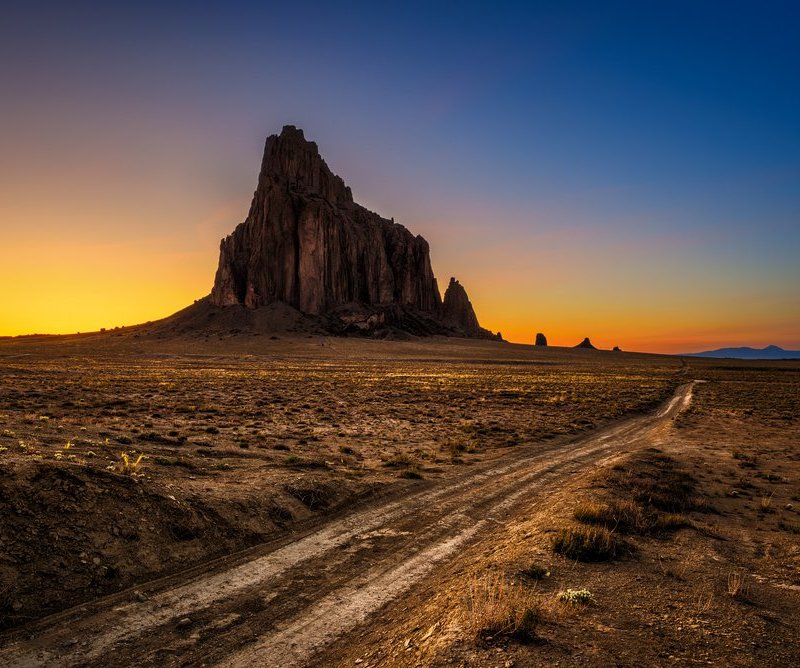
Out of nowhere it appears: 7,000 feet above sea level, the remains of a volcano that erupted some 30 million years ago, standing powerfully and dominating in the New Mexico desert that spreads out around it. Located just 15 miles southwest of the small town of Shiprock, New Mexico, the rock formation seems out of place, alone, and unchallenged among the landscape, making it the dominating feature of the land in all directions.
Videos by TravelAwaits
What makes the Shiprock formation so unique is that it’s one of the best U.S. examples of what’s called a diatreme. When that giant volcano erupted, the lava interacted with water to form a carrot-shaped volcanic vent (diatreme). The top layers of the volcano eroded over time, leaving behind the rock mountain we see today.

The name Shiprock comes from early pioneers who settled in the area. They believed the rock peak resembled a 19th-century clipper.
Shiprock encapsulates an image that can only be defined as otherworldly, and is why it has been used as the backdrop for nine feature films, dating back to the 1946 Western My Darling Clementine starring Henry Fonda.
The Legend
For centuries, the towering “rock with wings” has been sacred to the Navajo people, who call it Tse Bit’ a’i.
One legend tells of monster, flesh-eating birds who lived on the peak of Shiprock. One day, a warrior killed two of the bird monsters, then turned one baby bird monster into an eagle and another into an owl.

According to another legend, the mysterious Shiprock is all that remains of a giant bird that once carried the people’s ancestors to New Mexico from territories up north. These original Navajos lived on the rock and would only descend to tend to their crops below. The legend continues that one day when the men were down below, lightning struck and destroyed the pathway back to the top. The women and children who were trapped on the top starved to death. The elders then forbid anyone to climb Shiprock for fear that the ghosts of those stranded would be disturbed.
Despite the legends, in the 1930s, rock climbing grew in popularity and Shiprock became a highlight for many climbers seeking to scale the steep sides. The stories of the attempts both successful and failed became legendary in the world of climbing and are documented in the book 50 Classic Climbs of North America. But, an accident in the late 1960s paved the way for the Navajo nation to ban climbing in accordance with their beliefs. The rule still exists to this day.

Visiting Shiprock Today
Shiprock is as sacred to the Navajos in 2021 as it has ever been. There is no hiking, camping, or climbing allowed on the peak or the rock formations that surround it. Driving on the dirt road that leads to Shiprock is also prohibited. Visitors are asked to view and photograph Shiprock from a paved roadway, Indian Service Route 13, or from U.S. Highway 491. The Navajo community oversees these rules stringently.
The town of Farmington, New Mexico, is a good place to seek lodging and accommodations while you plan a day trip to see Shiprock. The town is less than 30 miles east of Shiprock. From Farmington, take US 64 west. As you near US 491, bear left and continue for 7.1 miles. You’re looking for Indian Route 13. When you see it, turn right and continue for another 7.6 miles, then turn right on IR 5010, which is a dirt road. Follow that another 3.5 miles to Shiprock.

Professional photographers have written about the best ways to photograph Shiprock. From a lighting perspective, the winter months are better than the summer, but note that in June an abundance of wildflowers can provide a stunning and contrasting foreground image.
Sunrise from the south is the best time to photograph Shiprock, although sunset is also fine, though the volcanic dykes that radiate from Shiprock will not be visible. Because access is so limited, some even suggest chartering an airplane to shoot aerials.
For more New Mexico inspiration, consider Exploring New Mexico’s Alien Throne In The Valley Of Dreams and 17 Reasons To Include Ghost Ranch In Your New Mexico Vacation.
